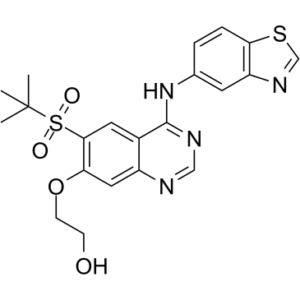GSK2983559 active metabolite
This product is for research use only, not for human use. We do not sell to patients.

For small sizes, please check our retail website as below: www.invivochem.com
| Size | Price | Stock |
|---|---|---|
| 250mg | $1850 | Check With Us |
| 500mg | $2450 | Check With Us |
| 1g | $3675 | Check With Us |
Cat #: V6404 CAS #: 1423186-80-4 Purity ≥ 98%
Description: GSK2983559 active metabolite, formerly known as RIPK2-IN-1, is an active metabolite of GSK2983559 which is a potent and selective inhibitor of receptor interacting protein-2 (RIP2) kinase.
Top Publications Citing Invivochem Products
Publications Citing InvivoChem Products
Product Promise

- Physicochemical and Storage Information
- Protocol
- Related Biological Data
- Stock Solution Preparation
- Quality Control Documentation
| Molecular Weight (MW) | 458.55 |
|---|---|
| Molecular Formula | C21H22N4O4S2 |
| CAS No. | 1423186-80-4 |
| SMILES Code | O=S(C1=CC2=C(NC3=CC=C(SC=N4)C4=C3)N=CN=C2C=C1OCCO)(C(C)(C)C)=O |
| Synonyms | GSK 2983559 ; RIPK2-IN-1; RIPK2 IN 1; RIPK2IN1; GSK2983559-AM, GSK2983559-active metabolite; GSK2983559; GSK-2983559 ; RIPK2 inhibitor-1; RIPK2 inhibitor 1; |
| Protocol | In Vitro | GSK2983559 active metabolite is a novel prodrug of a quinazolyl amine that inhibits RIP2 kinase. Receptor interacting protein-2 (RIP2) kinase, which is also referred to as CARD3, RICK, CARDIAK, or RIPK2, is a TKL family serine/threonine protein kinase involved in innate immune signaling. RIP2 kinase is composed of an N-terminal kinase domain and a C-terminal caspase-recruitment domain (CARD) linked via an intermediate (IM) region. The CARD domain of RIP2 kinase mediates interaction with other CARD-containing proteins, such as NODI and NOD2. NODI and NOD2 are cytoplasmic receptors which play a key role in innate immune surveillance. They recognize both gram positive and gram negative bacterial pathogens and are activated by specific peptidoglycan motifs, diaminopimelic acid (i.e., DAP) and muramyl dipeptide. |
|---|
These protocols are for reference only. InvivoChem does not
independently validate these methods.
| Solvent volume to be added | Mass (the weight of a compound) | |||
|---|---|---|---|---|
| Mother liquor concentration | 1mg | 5mg | 10mg | 20mg |
| 1mM | 2.1808 mL | 10.9039 mL | 21.8079 mL | 43.6157 mL |
| 5mM | 0.4362 mL | 2.1808 mL | 4.3616 mL | 8.7231 mL |
| 10mM | 0.2181 mL | 1.0904 mL | 2.1808 mL | 4.3616 mL |
| 20mM | 0.1090 mL | 0.5452 mL | 1.0904 mL | 2.1808 mL |
The molarity calculator equation
Mass(g) = Concentration(mol/L) × Volume(L) × Molecular Weight(g/mol)
Mass
=
Concentration
×
Volume
×
Molecular Weight*
The dilution calculator equation
Concentration(start)
×
Volume(start)
=
Concentration(final)
×
Volume(final)
This equation is commonly abbreviated as: C1 V1 = C2 V2
Concentration(start)
C1
×
Volume(start)
V1
=
Concentration(final)
C2
×
Volume(final)
V2
Step One: Enter information below
Dosage mg/kg
Average weight of animals g
Dosing volume per animal µL
Number of animals
Step Two: Enter the in vivo formulation
%DMSO
+
%
+
%Tween 80
+
%ddH2O
Calculation Results:
Working concentration:
mg/ml;
Method for preparing DMSO master liquid:
mg
drug pre-dissolved in
µL
DMSO(Master liquid concentration
mg/mL)
,Please contact us first if the concentration exceeds the DMSO solubility of the batch of drug.
Method for preparing in vivo formulation:
Take
µL
DMSO master liquid, next add
µL
PEG300, mix and clarify, next add
µL
Tween 80,mix and clarify, next add
µL
ddH2O,mix and clarify.
Note:
- (1) Please be sure that the solution is clear before the addition of next solvent. Dissolution methods like vortex, ultrasound or warming and heat may be used to aid dissolving.
- (2) Be sure to add the solvent(s) in order.




































